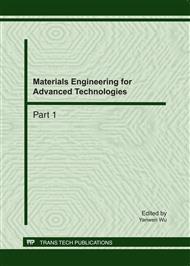p.256
p.261
p.266
p.272
p.278
p.283
p.288
p.294
p.300
Analysis of Top Value-Added Utilization of Waste Leaves from Rosewood Tree by GC/MS
Abstract:
Rosewood tree has high adaptability to environment and tolerance to water stress, and a long history of utilization and plantation in many countries. However, researches on Rosewood were mostly focused on the biomass analyses and utilizations of its wood, and lacked those to analyze the chemical components of extractives of Rosewood leaves, which was very important to recover and utilize the polluting waste Rosewood leaves. Therefore, the chemical components of benzene/ethanol extractives of Rosewood leaves were analyzed by method of GC/MS in order to identify top value-added bioactive components from waste leaves of Rosewood tree. The analytical result showed that the main components of benzene/ethanol extractives of freeze-dried Rosewood leaves by GC/MS analysis were identified 16 constituent (16 peaks) as: Ethanol, 2-butoxy- (40.36%), 2-O-Methyl-D-mannopyranosa (18.22 %), Hydrazine, 1,1-dipropyl- (6.09%), 1-Docosanol (5.59%), 1-Eicosanol (5.28%), Oxirane, hexadecyl- (3.63%), trans-2,4,5-Trimethoxy-.beta.-methyl- (3.50%), Bicyclo[3.1.1]heptane, 2,6,6-trimethyl- (2.53%), 9,12,15-Octadecatrienoic acid, methyl- (2.43%), Tetratetracontane (2.31%), Hexadecane, 1-(ethenyloxy)- (2.27%), Cholan-24-oic acid, 7,12-bis(acetyloxy)-3-ethoxy-, methyl ester, (3.alpha.,5.beta.)- (2.10%), Hexatriacontane (2.02%), Phytol (1.76%), Octadecane, 1-chloro (1.08%), etc. As the first report here, our result by GC/MS showed that the benzene-methanol extractive of freeze-dried Rosewood leaves can be developed into top value-added materials of medicines, biofuel, and industrial solvents.
Info:
Periodical:
Pages:
278-282
Citation:
Online since:
June 2011
Authors:
Price:
Сopyright:
© 2011 Trans Tech Publications Ltd. All Rights Reserved
Share:
Citation:


